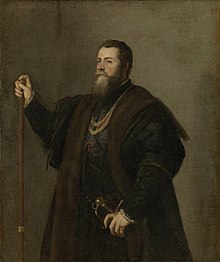Pedro de Toledo y Zúñiga
This article needs additional citations for verification. (August 2012) |
Pedro de Toledo | |
|---|---|
 Portrait by Titian, 1542 | |
| Viceroy of Naples | |
| In office 4 September 1532 – 21 February 1553 | |
| Monarch | Charles V |
| Preceded by | Pompeo Colonna |
| Succeeded by | Pedro Pacheco de Villena |
| Personal details | |
| Born | 13 July 1484 Madrid, Crown of Castile |
| Died | 21 February 1553 (aged 68) Florence, Republic of Florence |
| Spouse(s) | María Osorio y Pimentel, 2nd Marquise of Villafranca del Bierzo |
| Children | Eleanor of Toledo |
Pedro Álvarez de Toledo y Zúñiga (13 July 1484 – 21 February 1553) was a Spanish politician. The first effective Spanish
Biography
Early life
He was born in 1484 near
Viceroy of Naples
Spain took over the Kingdom of Naples in 1503 and solidified her grasp after the final, failed attempt by France in 1529 to retake the kingdom. For the first three decades of the century, a succession of inconsequential viceroys ruled the vicerealm. Don Pedro arrived as viceroy in September 1532.
Don Pedro’s rebuilding of the city went on for years. Old city walls were expanded and an entirely new wall was built along the sea front. Fortresses along those walls and further up and down the coast from the city were modernized, and the Arsenale—the naval shipyards—were expanded considerably. Don Pedro also built the viceregal palace as well as a dozen blocks of barracks nearby, a square grid of streets lined with multi-storied buildings—unique in Europe for its time. Today, that section of Naples is still called the “Spanish Quarter”. The goal was to make not just the city of Naples, but the Gulf of Naples and eventually, the entire vice-realm invulnerable—that is, the entire southern Italian peninsula.
Don Pedro ruled harshly. In 1542 he closed the
Don Pedro is remembered as the viceroy who tried without success to institute the Spanish Inquisition in Naples, in 1547. When the announcement of the Inquisition finally came in May 1547, the protest was immediate, turning violent very quickly. It was not a "popular" revolution, but rather a revolt by many of the landed nobility in and around Naples and Salerno, property owners who knew that the Inquisition had a reputation for confiscating the wealth and property of those whom it questioned. Additionally his Jewish chief financier Samuel Abravanel along with his wife Benvenida, may have had some influence on him, in regards to ending his aspirations of an Inquisition.[2]
Don Pedro, upon the order of the emperor
Don Pedro's reputation as a city-builder has stood the test of time. The city of Naples still bears his stamp in countless places. He was supposed to be entombed in the church of
Family
Ancestry
| Ancestors of Pedro de Toledo y Zúñiga | |||||||||||||||||||||||||||||||||||||||||||||||||||||||||||||||||||||||||||||||||||||||||||||||||||||||||||||||||||||||||||||||||||||||||||||||||||||||||||||||||||||||||||||||||||||||||||||||||||||||||||||||||||||||||||||||
|---|---|---|---|---|---|---|---|---|---|---|---|---|---|---|---|---|---|---|---|---|---|---|---|---|---|---|---|---|---|---|---|---|---|---|---|---|---|---|---|---|---|---|---|---|---|---|---|---|---|---|---|---|---|---|---|---|---|---|---|---|---|---|---|---|---|---|---|---|---|---|---|---|---|---|---|---|---|---|---|---|---|---|---|---|---|---|---|---|---|---|---|---|---|---|---|---|---|---|---|---|---|---|---|---|---|---|---|---|---|---|---|---|---|---|---|---|---|---|---|---|---|---|---|---|---|---|---|---|---|---|---|---|---|---|---|---|---|---|---|---|---|---|---|---|---|---|---|---|---|---|---|---|---|---|---|---|---|---|---|---|---|---|---|---|---|---|---|---|---|---|---|---|---|---|---|---|---|---|---|---|---|---|---|---|---|---|---|---|---|---|---|---|---|---|---|---|---|---|---|---|---|---|---|---|---|---|---|---|---|---|---|---|---|---|---|---|---|---|---|---|---|---|---|
| |||||||||||||||||||||||||||||||||||||||||||||||||||||||||||||||||||||||||||||||||||||||||||||||||||||||||||||||||||||||||||||||||||||||||||||||||||||||||||||||||||||||||||||||||||||||||||||||||||||||||||||||||||||||||||||||
Descendants
Don Pedro Álvarez de Toledo married in 1508 Maria Osorio Pimentel, 2nd
- Grand Duke of Tuscany. With issue.
- Fadrique Álvarez de Toledo y Osorio, 3rd Marquess of Villafranca del Bierzo; (1510 - 1569). 3rd Marquess on the death of his mother in 1539. He married Inés Pimentel, but no issue.
- Colonna, having issue, Pedro, who survived till 1627.
- Ana de Toledo, married Lopo de Moscoso Osório , 4th count of Altamira.
- Juana Álvarez de Toledo, married Fernando Ximenez de Urrea, 2nd Count of Aranda
- Isabel de Toledo, married Gian Battista Spinelli, 2nd Prince of Cariati
- Viceroy of Naples for 2 months in 1552, commander in the Order of Santiago.
References
Citations
- mozaraborigin
- ^ "Benvenida Abravanel | Jewish Women's Archive". jwa.org. Retrieved 2020-05-20.
- ^ (in Italian)Via Toledo in Naples, information[permanent dead link]
Other sources
- Amabile, Luigi (1892). Il santo Officio della Inquisizione in Napoli (in Italian). Città di Castello, Italy: S. Lapi.
- Croce, Benedetto (1915). Storia del Regno di Napoli (in Italian). Bari, Italy.
{{cite book}}: CS1 maint: location missing publisher (link) - De Seta, Cesare (1981). Le Città nella Storia d'Italia: Napoli, 'Il Viceregno' (in Italian). Bari, Italy: Laterza. pp. 106–128.
- Domínguez Ortiz, Antonio (1971). Los judeoconversos en España y América (in Spanish). Madrid, Spain.
{{cite book}}: CS1 maint: location missing publisher (link) - "Don Pedro de Toledo". Around Naples Encyclopedia. September 2008. Archived from the original on 2008-05-09. Retrieved 20 January 2009.
- Tejada, Francisco Elías (1958). Nàpoles hispanico (in Spanish). Madrid, Spain.
{{cite book}}: CS1 maint: location missing publisher (link)
